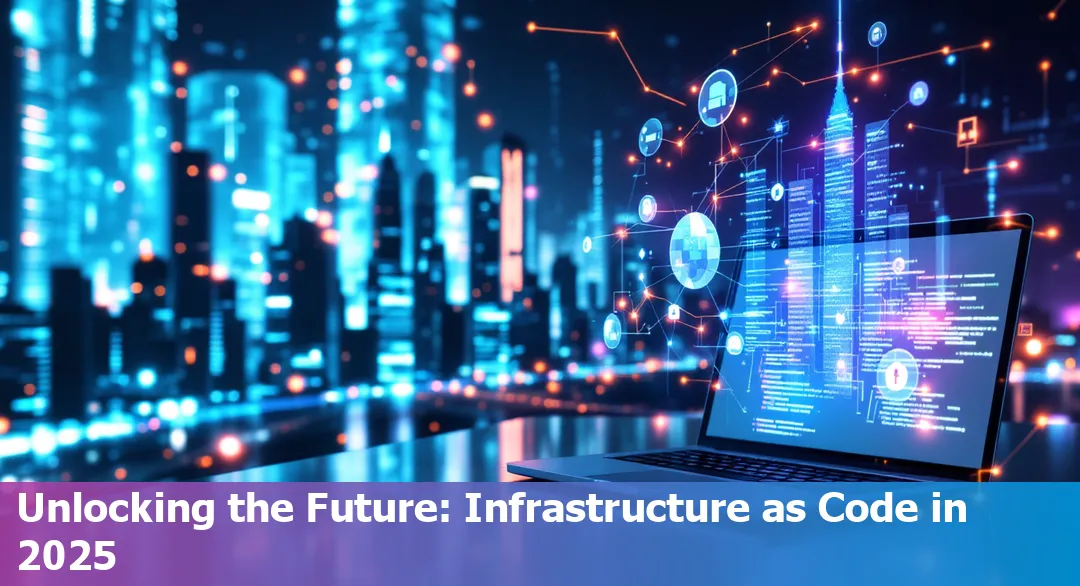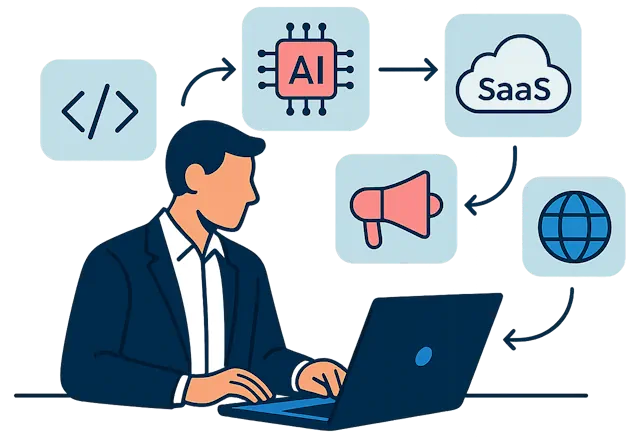Infrastructure as Code: What Backend Developers Need to Know in 2025
Last Updated: February 20th 2025

Too Long; Didn't Read:
In 2025, Infrastructure as Code (IaC) is essential for backend developers, with a 92% adoption rate. Tools like Terraform, OpenTofu, and AWS CloudFormation automate setup, enhancing speed by 30%. Containerization with Docker and Kubernetes makes applications efficient, cutting resource usage by 30%. Automated documentation boosts productivity by 40%. Embracing these technologies is critical for creating scalable, sustainable systems.
Infrastructure as Code (IaC) has completely transformed backend development in 2025, making it easier than ever to automate infrastructure setup and management.
IaC tools have revolutionized how operations and development teams interact, eliminating the headaches of manual configurations.
The tech stack in 2025 includes powerhouse tools like Terraform, OpenTofu, and AWS CloudFormation, which use straightforward declarative methods to handle complex backend processes.
According to recent data, teams using IaC are crushing it - delivering software 30% faster than those stuck with old-school approaches. By codifying infrastructure, IaC enables automation, consistency, and repeatable processes that seriously boost productivity.
The whole development game has changed, with shared code repositories and infrastructure templates becoming the standard.
IaC's automation capabilities let backend developers focus on solving real problems instead of getting bogged down in manual setups.
With a massive 92% adoption rate among backend teams, it's clear that IaC isn't just a trend - it's the future of how we build and maintain backend systems.
This intro sets up our deep dive into the tools, containers, trends, and skills that are essential for backend development in 2025.
Table of Contents
- Essential IaC Tools for Backend Developers
- Role of Containerization and Orchestration
- Emerging Trends in Backend Development
- Best Practices for Automated Documentation
- Advanced Features and Skills Required for 2025
- Frequently Asked Questions
Explore the essentials of mastering programming languages like Python for a successful backend developer journey.
Essential IaC Tools for Backend Developers
(Up)Infrastructure as Code (IaC) tools have totally changed how we handle backend development in 2025. Terraform and OpenTofu are leading the pack, each bringing something unique to the table.
Terraform's been crushing it with multi-cloud support and a huge collection of providers, making it super easy to manage different cloud platforms all at once.
OpenTofu is seriously shaking things up since it split from Terraform. It's kept all the cool features we loved about Terraform but added some sweet improvements, like better state encryption and variable handling.
Plus, it's completely open-source, which is pretty awesome for developers who care about community-driven development.
CloudFormation has its own advantages, especially if you're all-in on AWS. It's got this seamless integration with AWS services that's hard to beat, and you don't have to worry about managing state files like you do with Terraform or OpenTofu.
That said, it's AWS-only, which can be limiting if you're trying to work across different cloud platforms. What's really interesting is that more developers are choosing Terraform or OpenTofu over CloudFormation, even for AWS projects, because they're more predictable and flexible.
These tools are basically like having a super-smart assistant who remembers exactly how you like your infrastructure set up.
Just write it once, and boom - you can deploy the same setup anywhere, anytime. It's perfect for when you're building microservices or setting up dev environments.
The best part? No more spending hours clicking through console screens or trying to remember how you configured something six months ago. Everything's in code, version-controlled, and ready to go.
Role of Containerization and Orchestration
(Up)Docker and Kubernetes are completely reshaping how we handle backend development in 2025, making complex applications way more manageable. Docker's containerization approach lets developers package applications with all their dependencies, solving the classic "it works on my machine" problem once and for all.
The shift is real - companies are moving towards simpler, more efficient setups. While Docker handles the packaging, containerization has revolutionized how we build, ship, and run applications, making development cycles faster and more reliable than ever before.
What's super interesting is how some companies are actually stepping back from Kubernetes for development environments, choosing simpler solutions for certain use cases while keeping it for production workloads where it really shines.
The latest data shows that containerized apps use about 30% less resources compared to traditional setups, which is huge for both cost savings and environmental impact.
For developers just starting out, containers make it incredibly easy to experiment with different tech stacks without messing up your local environment.
The tools have matured so much that you can now spin up a complete development environment in minutes, not hours or days like before. With automated deployment pipelines and scaling capabilities, these technologies are making backend development more accessible while still maintaining the power to handle massive production workloads.
Whether you're working on a small project or a huge enterprise application, understanding these tools isn't just nice to have anymore - it's becoming as essential as knowing your main programming language.
Emerging Trends in Backend Development
(Up)Backend development in 2025 is experiencing a major transformation, with serverless computing leading the charge.
The pay-as-you-go model and automatic scaling capabilities are making it easier than ever to deploy applications without the headache of managing infrastructure.
We can now focus purely on writing code while cloud providers handle all the heavy lifting.
Along with this shift, zero-trust architectures and advanced security tools like Snyk and SonarQube are becoming essential, catching vulnerabilities before they cause problems in production.
The coolest part is how Backend as a Service (BaaS) and frameworks like Spring Boot are making development super efficient.
We're seeing AI get integrated everywhere - from automatically adjusting server capacity during traffic spikes to optimizing database queries based on usage patterns.
What's really interesting is how local AI coding assistants are becoming a thing, giving us more control over our sensitive data while still providing the benefits of AI-powered development.
The best part? These tools are actually making our apps more energy-efficient and environmentally friendly.
It's pretty amazing how we can build powerful, scalable applications while being mindful of our environmental impact.
The backend landscape keeps evolving, and staying on top of these trends is crucial for creating systems that are both powerful and sustainable.
Best Practices for Automated Documentation
(Up)Documentation automation has totally changed the game in 2025, making it way easier for developers to keep track of everything without losing their minds over manual updates.
Modern documentation tools are now super smart, using AI to handle repetitive tasks and even predict potential issues before they pop up.
The cool thing is that these tools aren't just about writing docs - they're actually making the whole development process smoother. According to recent data, teams using automated documentation are seeing their productivity jump by nearly 40%, which is pretty incredible.
What's really making waves is how document generation platforms are getting better at real-time collaboration, letting distributed teams work together seamlessly whether they're coding from home or at the office.
The latest tools can grab data from multiple sources, format it automatically, and keep everything in sync with version control systems. A major breakthrough this year is how software documentation practices have evolved to include visual and interactive elements, making complex technical concepts easier to understand.
Developers can now focus more on writing actual code while these tools handle the documentation heavy lifting, which honestly makes everyone's life so much better.
Plus, with most platforms offering integration capabilities with existing tools like Jira and GitHub, it's becoming super straightforward to keep documentation and development in perfect sync.
Advanced Features and Skills Required for 2025
(Up)The backend development world is changing super fast as we head into 2025, and staying on top of the latest infrastructure skills is absolutely crucial. Let's break down what really matters: microservices architecture is becoming the go-to approach for building scalable applications.
It's pretty amazing - you can develop and scale different parts of your application independently, which makes the whole system way more resilient. The stats are mind-blowing: almost 90% of big companies will be using microservices by 2025, compared to just 72% in 2023.
When it comes to managing infrastructure, modern practices are all about automation and efficiency.
Tools like Terraform and Docker are total game-changers. They make it so much easier to set up and maintain infrastructure - imagine being able to spin up entire environments with just a few lines of code! Docker is especially huge right now, with practically all Fortune 500 companies using it because it just works so well at keeping everything consistent across different environments.
One thing that's becoming seriously important is system monitoring.
According to recent research, advanced monitoring skills could prevent more than 70% of system crashes before they even happen.
Tools like Prometheus and Grafana give you real-time insights into how everything's performing. It's like having a dashboard that shows you exactly what's going on with your application at all times.
These skills aren't just nice-to-have anymore - they're absolutely essential for anyone wanting to make it in backend development. The whole field is evolving at lightning speed, and keeping up with these changes is what sets great developers apart from the rest.
Frequently Asked Questions
(Up)What are the essential Infrastructure as Code tools for backend developers in 2025?
In 2025, essential Infrastructure as Code (IaC) tools for backend developers include Terraform, OpenTofu, and AWS CloudFormation. Terraform offers multi-cloud support and extensive provider options, OpenTofu provides improved state encryption and variable handling, and AWS CloudFormation integrates seamlessly with AWS services.
How has containerization affected backend development?
Containerization, through tools like Docker and Kubernetes, has transformed backend development by making complex applications more manageable and reducing resource use by about 30%. It allows developers to package applications with all dependencies, facilitating easier experimentation and faster development cycles.
What are the major trends in backend development in 2025?
Major trends in backend development for 2025 include the adoption of a pay-as-you-go model, automatic scaling capabilities, security tools like Snyk and SonarQube, and AI integration for optimizing infrastructure and improving energy efficiency.
How has automated documentation improved development processes?
Automated documentation in 2025 enhances development by utilizing AI to predict potential issues and aid real-time collaboration. This leads to productivity improvements of nearly 40% and simplifies keeping documentation in sync with development processes.
What advanced skills and features are necessary for backend development in 2025?
Advanced skills for backend development in 2025 include proficiency in microservices architecture and system monitoring tools like Prometheus and Grafana. Automation tools like Terraform and Docker are also crucial for efficiently managing infrastructure.
One of the most anticipated advancements includes OpenTelemetry's industry standardization, which promises to streamline how organizations approach telemetry data.
Delve into the challenges like complexity and eventual consistency when implementing event-driven systems.
Simplify API deployment by leveraging cloud platforms and CI/CD pipelines to streamline development processes.
Engaging teaser sentence three, where the relevance in 2025 is hyperlinked.
Explore how Cloud-based solutions in data engineering are setting new industry standards.
Stay ahead in the tech landscape by understanding the Emerging trends in CI/CD for Python backends that are shaping the future.
Learn why agility and risk mitigation are the backbone of successful multi-cloud implementations in this fast-paced era.
The marriage of Python and TensorFlow Lite integration is setting new standards for mobile machine learning models.
Ludo Fourrage
Founder and CEO
Ludovic (Ludo) Fourrage is an education industry veteran, named in 2017 as a Learning Technology Leader by Training Magazine. Before founding Nucamp, Ludo spent 18 years at Microsoft where he led innovation in the learning space. As the Senior Director of Digital Learning at this same company, Ludo led the development of the first of its kind 'YouTube for the Enterprise'. More recently, he delivered one of the most successful Corporate MOOC programs in partnership with top business schools and consulting organizations, i.e. INSEAD, Wharton, London Business School, and Accenture, to name a few. With the belief that the right education for everyone is an achievable goal, Ludo leads the nucamp team in the quest to make quality education accessible

